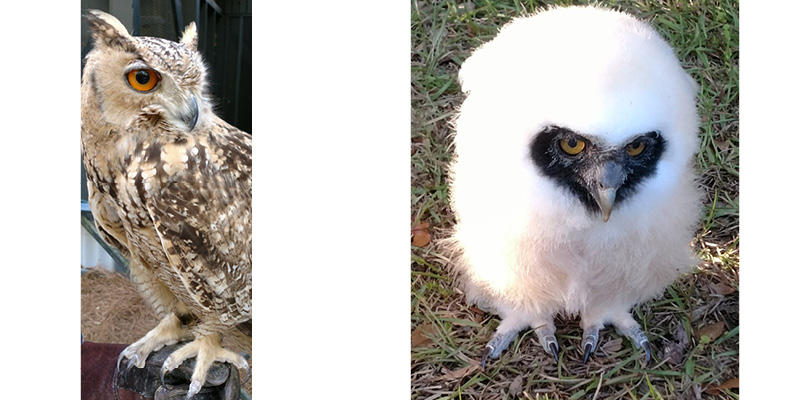
In late April, a friend and I had the good fortune to acquire tickets to a limited seating event at Awendaw’s Center for Birds of Prey. Called, Bird Songs, the evening was music in the round, under the stars, in the pines – with Nashville songwriters center stage, sharing stories, and singing. Many of the songs were familiar, having been played on the radio by some of Country music’s most popular singers. The very special evening was a fundraiser for the Center, going toward avian science and conservation
Upon entry to the event, owls and birds of prey were on the hands of the well-trained staff, for guests to walk up and get a closer view of these magnificent creatures. How often do we get to look into the eyes of a peregrine falcon, an African wood owl, a barred owl, or a red-tailed hawk? The beauty of these birds is something you cannot easily forget. They live a life high above us, in the trees, deep woods, along river banks and over vast ponds or desert plains – rarely does any human come close to birds of this caliber; they are not our backyard birds!
An African kite, a beautiful large bird resembling an Eagle, flew acrobatically over the crowd, flying at fast speed, without making any sound. Owls and many birds have a special ability to fly without sound, thereby able to grab unsuspecting prey. Birds have hollow bones, enabling them to fly long distances without getting tired.
On this special night of Bird Songs, guests walked into the main event area, a dirt floor surrounded by trees and owls in their well-built, large cages. These curious avians peered out at the humans peering back at them. One little duo, the burrowing owl, was particularly interesting. Instead of being above ground on branches, it prefers to hop along the ground and ‘burrow’ in tunnels. The screech owl, common to SC, was hiding in his back ‘cave’ difficult to see. A small owl, once you hear one in the wild you’ll not soon forget the beautiful, mysterious sound he makes.
Not all owls are nocturnal as we found out. Many prefer to fly and look for food during twilight hours of dusk or dawn, thus you may very well hear owls hooting in nearby woods before the sun fully sets, and as it rises. Most owls, however, do hunt at night, and they can see in the dark with their fabulous eyes.
As the evening progressed, we sat under live oaks for a fabulous dinner from Charleston’s Hamby’s catering: white linen tablecloths, fresh cut flowers, china and silverware decorated the tables. People were from all over the area, many had been to this special event before. Guests casually met one another, talked about why they were there, where they’d been traveling, and where they lived. Conversations and laughter surrounded each table.
Afterwards, guests took their seats in the round, as night fell, a full moon arose – the music began, and the night became even more magical. The songwriters took turns telling stories, strumming guitars and mandolins and singing their songs. All around were birds, some hooting, some sleeping, but they were there, it was so special to be outdoors in the woods surrounded by these magnificent creatures.
The Center for Birds of Prey is a one of a kind 152-acre campus, a world-class sanctuary for our avian friends, treating injured birds of prey and shorebirds. The Center houses the Avian Medical Clinic, which currently treats more than 600 injured raptors and shorebirds each year, releasing the majority back to their natural habitat. Injured birds are admitted from a continually widening geographical area. In addition, the Center houses a special facility for ‘oiled birds’, those that are victim to an oil spill – and is the only permanent avian treatment center of its kind on the Eastern seaboard. Each year, thousands of students engage in the Center’s science and natural history based educational programs.
Birds that ‘prey’ are not like our garden songbirds, or shorebirds, those we are most familiar with. Birds of Prey are the magnificent, high performing bird that fly at speeds hard to comprehend – a Golden Eagle can fly up to 200 mph. The fastest living creature on earth, the peregrine falcon, has a speed of up to 242 mph. With eyesight so good these special creatures can spot a mouse on the ground from hundreds of feet in the air – dive down at record speed and scoop up their prey.
The Eagle has the best eyesight of all birds, with the ability to spot their prey up to 2 miles away. This is about eight times as far as humans can see.
Throughout the evening, while the musicians sang, several owls hooted from their roost behind us as if to say ‘isn’t this great’?! In the distance, the lonesome unmistakable call of a Chuck Wills Widow sweetly sang his unique, beautiful song. I wonder how many other birds come to the Center to visit those that have been injured, perhaps to give comfort to their avian cousins.
The Center for Birds of Prey is a wonderful place for some of our most special avian creatures. The lush landscaping around the large, comfortable bird cages brings a sense of peace and calm to the grounds – great care has been taken to keep the surroundings as natural as can be.
Bird Songs was just one of many fabulous events the Center hosts throughout the year. Easy to get to, the Center is located just minutes up Hwy 17 North, on the outskirts of Mount Pleasant near See Wee Outpost. As you turn into the property, you will be instantly transported into deep woods and the feeling you are definitely in a special place – a bird sanctuary. For more information visit: http://www.thecenterforbirdsofprey.org/